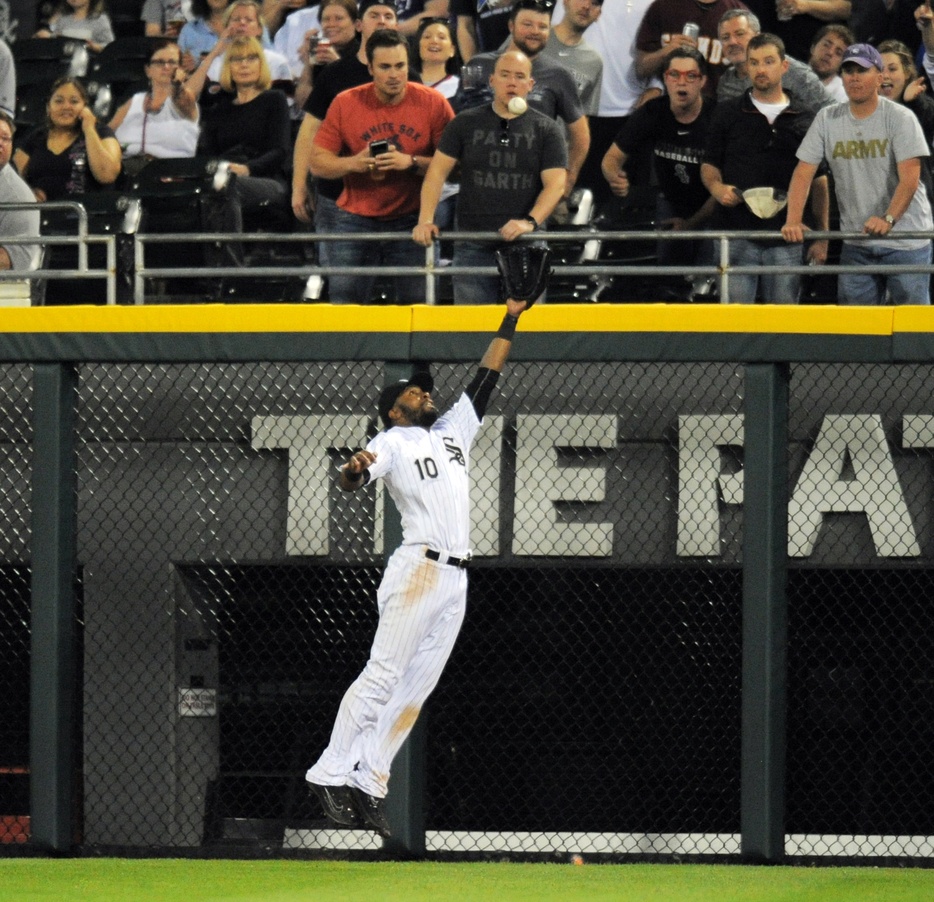The White Sox are 23-10. Last year on May 10 the White Sox beat Cincinnati by one run to move to 12-16. They are better this year. No doubt this is the hard-hitting statistical analysis you have come to expect from Baseball Prospectus. There are some very visible reasons for the improvement. The 2015 White Sox finished dead last in MLB with a team TAv of .247, whereas this year’s edition has been just a hair below league average, in a three-way tie for 16th at .258. Newcomers Brett Lawrie and Todd Frazier have both been above average bats (even though there’s reason to believe they can get more out of Frazier), Melky Cabrera has had a bounce-back season, and even Avisail Garcia has been daring some White Sox fans to hope once more.
But perhaps the most dramatic improvement from year-to-year has been on the defensive side of the ball. Obviously defensive metrics are really squishy — particularly when compared to hitting metrics — so I will tread carefully. Without getting into ~30-game samples for individual defenders or the type of contact being induced by the pitching staff, we can start by just looking at what is happening to balls in play on a pure results basis.
In 2015, the White Sox were 28th in MLB with a raw defensive efficiency of 68.9 — in other words, opposing hitters had a BABIP of .311 and 31 percent of balls put in play went for hits. This year, the White Sox have improved to a staggering degree, as they are now second best in the majors with a defensive efficiency of 72.9 i.e. they are converting 4 percent more balls in play into outs, holding their opponents to a BABIP of .271. For comparison’s sake, this rate eclipses even the 2005 championship roster that was widely lauded for its defensive prowess.*
*Massive defensive improvements have been a characteristic of other teams that have taken a leap from year-to-year in recent memory. The worst-to-first ’07-’08 Rays went from a distant last place (.331 BABIP allowed in 2007!) in defensive efficiency to best in all of MLB in one winter, in perhaps the most dramatic example one will find of this phenomenon.
The White Sox improvement as a team in this area is reflected in BP’s more advanced metric, PADE, which takes park factors into account. The White Sox still weigh in at third in MLB by this metric, up from 27th in 2015. Moreover, much has been made about Chris Sale’s concerted effort to pitch more efficiently without trying to strike out 100 percent of the hitters he faces, and the better defense behind him apparently has a real effect on both his mentality and performance. Don Cooper explicitly commented upon the 2015 squad’s miserable defense and that Sale no longer needs to try to make up for his team’s defensive shortcomings, saying of 2016 Sale, “He’s not maxing out on every pitch, every inning … Last year, our defense wasn’t that good, and he felt he had to strike more guys out.” Sale himself attributed his disastrous first inning and subsequent dominance in his last start against Minnesota to being reminded that he actually has a good defense behind him this year:
“Just get back to where I need to be. I don’t need to strike everyone out,” said Sale, who smacked himself in the head twice with the baseball after hitting Polanco. “They’ve got my back behind me, and it’s true. The proof is in the pudding — guys are making plays behind me and making great plays. ‘Let us work behind you. You don’t have to overpower everyone.’ That’s really what got me back on track and I’m thankful for that.”
Indeed, despite posting a DRA of 2.36 last year, Sale still posted a pedestrian ERA. Sale definitely struggled with his command at times last year and was punished for it, but one has to imagine that a large part of the gap between Sale’s peripherals and his results in 2015 can be attributed to bad defense. And for a pitcher like Sale who visibly loses command in response to frustration, the impact of a good defense may go beyond just erasing potential extra-base hits and extra baserunners.
All of this jives with the eye test, as we make the leap to the subjective component that still is necessary when evaluating defense. Austin Jackson has looked great in center in his own right so far, and he has also allowed Adam Eaton to shift over to right field where he has thrived, both as a result of his own skill set and evidently because Jackson has been helping him with his positioning. The 2015 White Sox had a below-average-to-bad left fielder, a probably-below-average center fielder, and probably the worst right fielder in the league. One offseason later and they have improved noticeably in center, and taken a quantum leap forward in right. Therefore with one roster move, the White Sox were able to massively change the complexion of their defense. Sprinkle in the significant upgrade in the form of Frazier’s glove at third, and Jimmy Rollins likely losing playing time to superior defensive players as the season progresses, and there is every reason to believe that this is a real improvement for the roster moving forward.
Lead Photo Credit: Patrick Gorski/USA Today
